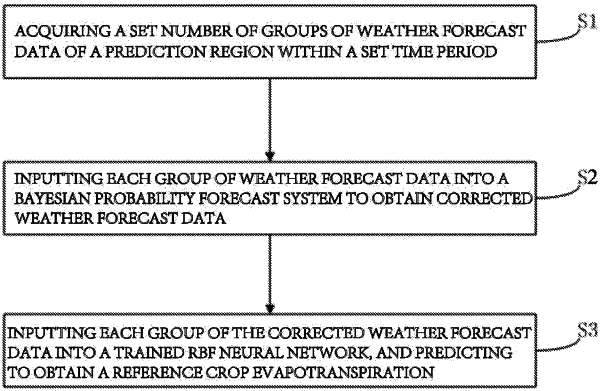| CPC G06F 18/214 (2023.01) [G06F 18/24155 (2023.01); G06N 3/047 (2023.01); G06N 3/08 (2013.01)] | 5 Claims |

|
1. A farmland reference crop evapotranspiration prediction method considering uncertainty of meteorological factors, comprising:
S1. acquiring a plurality of groups of weather forecast data of a prediction region within a preset time period;
S2. inputting the plurality of groups of weather forecast data into a Bayesian probability forecast system to obtain a plurality of groups of corrected weather forecast data; and
S3. inputting the plurality of groups of corrected weather forecast data into a trained radial basis function (RBF) neural network, and predicting to obtain a farmland reference crop evapotranspiration,
wherein a training method of a RBF neural network comprises:
A1. selecting a plurality of groups of past weather data, and adopting Penman equation to calculate a first reference crop evapotranspiration within a time corresponding to each of the plurality of groups of past weather data;
A2. adopting the plurality of groups of past weather data and the first reference crop evapotranspiration as inputs and outputs of the RBF neural network, respectively, and training the RBF neural network to obtain an initial RBF neural network model;
A3. acquiring a plurality of groups of past weather forecast data, and adopting the Penman equation to calculate a second reference crop evapotranspiration within a time corresponding to each of the plurality of groups of past weather forecast data;
A4. inputting the plurality of groups of weather forecast data in step A3 into the Bayesian probability forecast system to obtain corrected weather forecast data; and
A5. adopting the corrected weather forecast data in step A4 and the second reference crop evapotranspiration as inputs and outputs of the initial RBF neural network model, respectively, and training the initial RBF neural network model to obtain the trained RBF neural network.
|